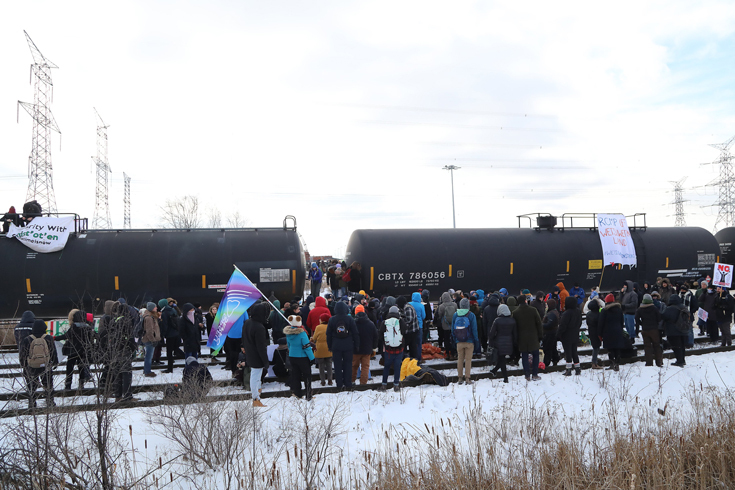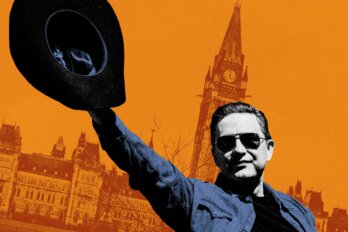On January 20, members of the Mohawk Nation in Ontario sent a letter to the Crown. It warned that the Silver Covenant Chain, one of the earliest treaties between Canada and First Nations, was in danger of breaking. The chain is not a physical object but rather a 343-year-old system of diplomacy. Its provisions call for leaders to meet whenever discord causes the pact to “tarnish.” Should the chain not be polished, the sides cease being allies—which can lead to violence or worse.
The warning was prompted by the RCMP’s incursion into Wet’suwet’en territory. Earlier in January, as protests mounted over the proposed Coastal GasLink pipeline in British Columbia, the RCMP set up an access-control checkpoint in the Wet’suwet’en Nation. Because Aboriginal title rights grant the Wet’suwet’en jurisdiction over their own land, the checkpoint was treated by protestors as an act of war. “Unceded Wet’suwet’en lands are under attack,” explained a widely shared notice from Unist’ot’en Camp.
The end result, as announced last week, is that the Wet’suwet’en hereditary chiefs will be signing a “memorandum of understanding” concerning their rights and title with the governments of Canada and BC on May 14. Whether this will settle tensions remains to be seen as the exact details of the memorandum are embargoed. It should, hopefully, be a milestone in a legal process that began with a 1984 lawsuit in which the Wet’suwet’en sought to clarify ownership of their traditional lands. The Supreme Court ruled that good-faith negotiations needed to take place, but Canada never followed through with the court’s decision. It was only when outcry over the Coastal GasLink project started having economic ramifications that the government finally acted.
The Mohawk Nation letter, however, appears to have played a vital role. It not only served notice that members were prepared to adopt the Wet’suwet’en’s cause as their own but reminded officials that agreements, once made, must be honoured. Their letter signed off, “In peace and in friendship.” At first, no one in the government responded. Recipients included Minister of Indigenous Services Marc Miller, Prime Minister Justin Trudeau, Governor General Julie Payette, and the Queen of England.
Matters soon deteriorated. On February 6, the RCMP started forcibly removing Wet’suwet’en matriarchs, land defenders, and other antipipeline demonstrators. The day these arrests began, members of the Mohawk Nation set up an encampment at the Wyman Road crossing, in Tyendinaga, Ontario, cutting off a main Canadian railway link. “We aren’t playing,” they told a Canadian National Railway (CN) constable, according to court affidavits obtained by APTN. “There will be a smash-up and blood on the tracks.”
Within days, the sit-in caused a nationwide shutdown of Via Rail train services and the closure of CN’s eastern Canada and BC operations. Other solidarity protests closed bridges, ports, the BC legislature, and border crossings. Officers delivered a court injunction to the Ontario blockade; demonstrators set the document on fire. “Obviously, we are a country of the rule of law and we need to make sure those laws are followed,” Trudeau explained regarding the conflict. But his government was being asked to follow another rule of law, one that had been in place longer than Canada itself.
The Silver Covenant Chain is among the oldest existing contracts between Indigenous North Americans and Europeans. The treaty, described in the nineteenth century as “more far-reaching in its effects than any other ever negotiated” between the two sides, not only brokered peace and trade but also managed any unrest that might arise. Though few Canadians seem aware of its existence, it still sets the terms of this country’s relations with dozens of First Nations.
The chain dates back to the early 1600s, when European settlers first started building homes on Indigenous territory in what is today New York. According to Onondaga Nation historians, the two civilizations couldn’t initially speak a common language, but they gradually found ways to communicate. The process required patience. Indigenous peoples did not use written contracts, relying instead on wampum belts and oral treaty councils, which is how the accord with settlers developed. At some point between 1613 and 1643, a rope used to fasten a Dutch trading ship to the shore came to represent the alliance between both sides. Ropes fray, so the covenant was eventually replaced by a figurative iron chain.
Once the British took control of New Netherland, renaming it New York, they, too, entered into the Covenant Chain treaty between the Dutch and the Haudenosaunee. By 1677, the Covenant Chain was upgraded from iron, which rusts, to silver. The fact that silver needs to be cared for is the essence of the Silver Covenant Chain; its tenets require leaders to meet and polish the links whenever they blacken. This can occur as a result of any disagreement or misunderstanding between signatories.
For modern-day purposes, the most important summit involving the Silver Covenant Chain was the 1764 treaty of Fort Niagara. Over a series of meetings involving 2,000 delegates, the Crown entered into a mutually binding engagement with twenty-four First Nations. Britain’s superintendent of Indian affairs, William Johnson, enacted this treaty by presenting Indigenous chiefs with a large wampum belt called “the great Belt of the Covenant Chain.” While the current legality of the chain is undeniable—the 1764 agreement ratified the Royal Proclamation of 1763, which is upheld by the 1982 Constitution Act—encoded into the wampum is the understanding that the covenant lasts forever: “As long as the grass is green, as long as the water flows downhill, as long as the sun rises in the East and sets in the West.” It can only be terminated if there’s a refusal to mend the silver. The last time the Silver Covenant Chain came undone was in New York, in 1753, shortly before the Seven Years’ War. A year later, the chain was reinstated at the 1754 Albany Congress. It has remained in place ever since.
To be clear: the Silver Covenant Chain does not apply to the Wet’suwet’en, who have not signed treaty accords with the government and who retain sovereign right over their territory. But, as a result of the Ontario train blockade, the newly strengthened alliance between the Wet’suwet’en hereditary chiefs and the Haudenosaunee suggests that any further steps forward by Parliament will likely require following the principles of the Silver Covenant Chain.
The January letter from members of the Mohawk Nation explained the chain’s provisions as follows:
1. When a serious problem arises, a request is made to polish the chain.
2. Both parties then meet and attempt to resolve the dispute amicably.
3. If these peaceful negotiations lead to a mutually agreeable outcome, gifts are exchanged and statements issued to the effect that the chain has been polished.
4. Should the bilateral agreement’s links not be shined—meaning a solution has not been found—the two sides are no longer allies.
On February 13, a week into the rail blockade, Trudeau’s cabinet finally responded to the message. “Pursuant to the principles of the Silver Chain Covenant, I hereby agree to Polish the Chain with you,” wrote Minister of Indigenous Services Marc Miller in an email confirming an in-person meeting with demonstrators—while also getting the treaty’s name wrong.
On the snowy morning of Saturday, February 15, Miller and his aides joined Mohawk leaders at the train tracks in Tyendinaga. The two sides met outside, in the cold of winter, at the railroad crossing. The January 20 letter was read aloud to Miller, to ensure that he’d absorbed its contents. “I can’t say I’ve read that letter or received it,” he replied. “I would tell you if I did, and I would tell you if I ignored it.”
“It needs to be known by your population that you ignored our requests,” responded the appointed speaker for the Mohawk side, Kanenhariyo. Also known as Seth LeFort, Kanenhariyo is the owner of a news network called Real People’s Media. He wore a ponytail and a septum ring (“like my ancestors wore while they killed Americans,” as he described it on Instagram.)
When it came time for Crown representatives and Indigenous chiefs to introduce themselves, no one could remember which side was supposed to go first. “It’s been so long since this happened,” Kanenhariyo said. “But it’s important that we have some humour ’cause humour is medicine, and we need to have healing.”
Miller and his cabinet members laughed tentatively, their breath sending bolts of steam into the freezing air. “Would you like to continue the conversation here?” asked Miller. Kanenhariyo replied that he felt it would be wise, for now, to stay where they were. The flat, icy fields surrounding them were the same hue as the porcelain wash of clouds in the overcast sky. A grey military aircraft floated by. Whipping around in the February wind was the blood-red flag of the Mohawk Warrior Society, depicting a shaved-sided male head crowned with a single feather.
A Mohawk knowledge keeper and language teacher named Tehahenteh led the ceremonial greeting, recounting how his people customarily perform several actions to ensure open communication between negotiators. First, they take the finest soft leather from the belly of a fawn to wipe away any tears so that both sides may see each other clearly. “When there’s great concern or trauma or anything of that nature, we say that death goes into your ears,” he continued calmly. “What we do is that we go to the other side of the Sky World, and we’ll bring the finest eagle feather, and that’s what we’ll use to pull that out from your ears so that you’ll be able to hear clearly, to understand what’s being said.”
Tehahenteh then spoke of how trauma can cause a blockage in our throats, which “makes it difficult to say what’s on our mind and what’s on our heart.” To heal that blockage, they supply the purest, most pristine water from the far side of the Sky World. “That’s what we use metaphorically,” he explained to the visiting delegation, “so that you’re able to speak in a proper and correct manner.”
Kanenhariyo then started discussing the Silver Covenant Chain. “Our relationship,” he said, “it’s so tarnished that you can barely see that it’s a chain anymore.” He wanted to know why it took nationwide transportation interruptions for the government to finally request to polish the chain.
“I think everyone now is googling what [our] traditional relationship is,” Miller said, “because it’s the first time most people thought about it.”
There’s nothing new about politicians being unaware of the Silver Covenant Chain. Indigenous groups have had to constantly remind settlers of the existence of treaties such as the chain and fight for the legal right to have these treaties recognized as valid by courts of law.
“Each new democratic leader leaves behind the policies of his predecessor, forgetting the agreements and lessons of the past, and the Roianeson [chiefs] must educate new political officials every term,” wrote Joyce Tekahnawiiaks King, director of the Mohawk Council of Akwesasne Justice Department, in a 2007 essay for the Cornell Journal of Law and Public Policy. She was specifically referring to the Silver Covenant Chain. Additionally, in another essay on the chain in the Journal of Early American History, Jon Parmenter, historian and legal consultant to the Oneida Indian Nation, noted, “One of the primary means by which settler colonialism sustains itself is through the denial of the authenticity or the antiquity of indigenous traditions or both.”
There has been some dispute over the validity of the Silver Covenant Chain in the past, primarily regarding the origins of the treaty and the legitimacy and provenance of various supporting documents. But that is no longer the case. Alongside the Canadian Constitution Act, a legal precedent was set in 1997 recognizing the legitimacy of oral histories in terms of Aboriginal title rights. The Supreme Court of Canada ruled that non-text-based traditions and verbal treaties must be placed “on an equal footing with the types of historical evidence that courts are familiar with, which largely consists of historical documents.”
The 1997 decision was an outcome of a land-claim case initiated by members of the Wet’suwet’en Nation. So it’s no surprise that the current protests against the pipeline in Wet’suwet’en are, once again, intertwined with the need for Aboriginal title rights to be judicially recognized. But, beyond the as-yet-unresolved question of nation-to-nation relations and Indigenous self-governance, there’s also a core environmental dimension to this conflict. Aboriginal title requires First Nations to protect the sanctity of their land. According to the 1997 decision, title land “has an inherent and unique value in itself”—and that land cannot be put “to uses which would destroy that value.”
Although the Coastal GasLink project gained the support of twenty elected band councils along its route, most of the hereditary Wet’suwet’en chiefs have always held the line: allowing pipelines to pass through unpolluted ecosystems, with the inherent risk of contaminants leaking into the water supply, violates their duty to the land.
Indeed, to Wet’suwet’en land defenders and Mohawk protesters, RCMP arrests on unceded territory don’t simply contravene Indigenous peoples’ right to self-determination—they undermine the very process of reconciliation and thus tarnish the Silver Covenant Chain. Whatever ends up happening in Wet’suwet’en seems destined to shape similar negotiations across the country. As a Gidimt’en statement explained on April 27: “The outcome of this fight for our lands and water will have far reaching repercussions for every Indigenous nation across so-called ‘canada’ for generations to come.”
Kanenhariyo held up a beaded belt to illustrate another wampum treaty linking both sides. This belt, a visual corollary to the Silver Covenant Chain, is known as the Two Row Wampum, or Tyohate. It, too, was entered into as a bond between Indigenous nations and the Canadian Crown at the 1764 Treaty of Fort Niagara. It, too, therefore, remains in effect to this day. After all, as Kanenhariyo reminded Miller at the tracks, the Two Row Wampum “didn’t grow whiskers and get old and pass away.”
The Two Row Wampum belt depicts two parallel lines representing separate vessels travelling down the river of life side by side. Settlers are in one canoe; First Nations in the other. Coexisting in harmony requires respecting the neighbouring vessel’s political and legal autonomy. The Two Row Wampum forbids either nation from interfering with the other’s way of life. In short, it expresses the law of this land as follows: you don’t steer the other’s boat.
“We see ourselves in our own ship with our own laws and our own rules and our own everything—and you in yours,” summarized Kanenhariyo. “If we can’t start there, then we’re not gonna get anywhere. So I’m asking you, Can we agree that we’re talking in this manner, in this context, so we can move forward?”
“I have difficulty talking about the Two Row because I’m only beginning to gain an appreciation of it,” said Miller. “It’s something, as I learn, I respect deeply. But we’ve got work in government to recognize that as a government. There are a number of other treaties that have not been respected.”
Silver Covenant Chain diplomacy stresses the importance of frank dialogue, and at various junctures during the daylong meeting with Miller, the mood darkened. “You’ve committed a crime,” stated Kanenhariyo. “And we’re disgusted with you. And we don’t want you stealing resources and running them through our land anymore, doing that kinda stuff. It hurts us, you know?” A community member later chimed in: “Double-talking half-truths ain’t shining the chain, guys!”
The encounter grew heated, but it was also useful. Miller returned to the cabinet and relayed what he’d learned, which helped inform the government of the need for patience. “Everyone wants to resolve this in a peaceful situation,” Miller explained in the House of Commons shortly after the meeting. “This is a discussion. It needs to be built on trust and open dialogue, which is what we’re doing.”
There were setbacks. On February 24, Ontario Provincial Police (OPP) cleared the Tyendinaga blockade set by Mohawk protesters, triggering new protests across the country. In Kahnawake, south of Montreal, a group of Mohawks led by female organizers and supported by the community had maintained a blockade halting rail traffic for more than three weeks. They released a statement expressing “outrage and disgust” about the OPP raid.
But part of what is so remarkable about the covenant is the way it guides each side back to a core point—finding a peaceful diplomatic resolution. The very identity of Canadians globally, as peacekeepers, stems from lessons learned, in part, from Indigenous treaty negotiations, as John Ralston Saul has argued. In 2008’s A Fair Country, he lists the Indigenous roots of Canadian civilization as follows: a passion for egalitarianism and inclusion; a tolerance for complexity; a “positive tension” between the individual and society at large; and an emphasis on the need for minority rights. As he concludes: “Our deep roots are Indigenous and there lie the most interesting explanations for what we are and what we can be.”
Even the legislative policy of multiculturalism—Pierre Elliott Trudeau’s contribution to our national identity—stems from an Indigenous approach to coexistence. As Justin Trudeau often says, “No relationship is more important to me and to Canada than the one with Indigenous peoples.” If he really means it, he may have no choice but to follow the rules codified by the Two Row Wampum and the Silver Covenant Chain.
As Miller conceded in his meeting with Mohawk representatives, the government has yet to acknowledge the full implications of those treaties. While “modest progress” was made during his time in Tyendinaga, a more significant breakthrough came on March 1, when Wet’suwet’en hereditary chiefs and the Canadian government announced that they’d hammered out the proposed memorandum of understanding that will be signed later this month. In the wake of that breakthrough, the Kahnawake community took down their Montreal train blockade on March 5 as a gesture of “good faith.”
BC premier John Horgan has been adamant that the Coastal GasLink pipeline project will proceed. In its April 27 statement, the Gidimt’en clan expressed regret that the memorandum of understanding did not “end the conflict on the ground” in the region. “Although this is a step in the right direction,” the statement reads, “CGL [Coastal GasLink] continues to trespass on Wet’suwet’en territory.”
The fate of the pipeline remains undetermined. CBC reports that CN has launched a lawsuit against protesters who blocked trains in February. And this much is still certain: the Silver Covenant Chain has not yet been polished.





